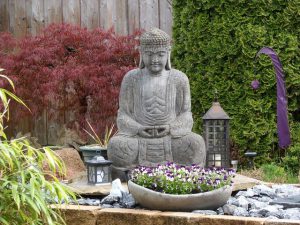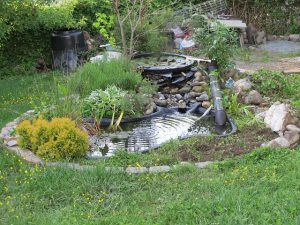Saturday
Featured StoriesCreating a Zen Garden
Just in time for Midsummer, here is a guide to creating a meditative space in your own backyard
by Sally Perkins
 Sometimes what we are looking for most can really can be found in our own backyard. Consider the great emphasis we place on meditation in Shambhala. In order to fully develop our fundamental nature of basic goodness, we of course must begin with the inward journey. While we actively work toward establishing calmness, peace, and sanity in our modern world, one way to support our practice is to create a space that nurtures just those characteristics, a space that is nearby — always accessible and available.
Sometimes what we are looking for most can really can be found in our own backyard. Consider the great emphasis we place on meditation in Shambhala. In order to fully develop our fundamental nature of basic goodness, we of course must begin with the inward journey. While we actively work toward establishing calmness, peace, and sanity in our modern world, one way to support our practice is to create a space that nurtures just those characteristics, a space that is nearby — always accessible and available.
By creating and keeping a Zen garden or similar outdoor space, we have access to one of the greatest ways to achieve some much needed serenity, calmness, meditation, and harmony in our daily life. The busier our lives may be, the more important it becomes to practice mindful meditation and contemplation. With the weather warming up, and summer coming on, this can be a great time to create a meditative space where we can directly encounter summer’s sunshine, breezes, and fresh air.
Regardless of what type of outdoor space we have to begin with, whether it is a backyard, a roadside strip of grass, or a corner of a community garden, we can customize an area of it to create our own little version of utopia. For many of us, such a space can help to stay connected to our practice, and to the Shambhala community of shared inspiration and collaboration. Here are some features to consider for a garden that can help “Zen-ify” our outdoor world and, in turn, our inner life.
Mark your space: Whether you are choosing pebbles, plants, or bamboo sticks, outline the space in your garden that you want to dedicate to your Zen outdoor space. Some people may choose to use an entire garden space, but many others opt for dedicating a portion of the overall space. How large or small you want to keep the area is up to each household, and can be personalized to match local or individual preferences. Just make a decision, and use pebbles, stones, plants, or bamboo to clearly mark the boundaries of the Zen garden area.
 Add a source of water: Whether it is a small stream or a little fountain, adding water to a Zen garden can make a real difference. The calming and soothing sound of water is one of the best ways to get into a meditative mindset. Surrounding yourself with this type of flow naturally relieves stress, and can provide some much needed mental clarity. The pleasure of listening to running water can make spending time in a Zen garden more attractive.
Add a source of water: Whether it is a small stream or a little fountain, adding water to a Zen garden can make a real difference. The calming and soothing sound of water is one of the best ways to get into a meditative mindset. Surrounding yourself with this type of flow naturally relieves stress, and can provide some much needed mental clarity. The pleasure of listening to running water can make spending time in a Zen garden more attractive.
 Dedicate space to sand: Ever notice a small sand plot on a person’s desk with a miniature rake? Raking smooth and soft sand is an extremely soothing and calming activity, and a great addition to a Zen garden. Store-bought sand plots are convenient and widely available, and it can also be fun to create a home-made one in our own garden. When you need to get into the Zen mindset, raking some soft sand while listening to the sounds of water can get you there in short order.
Dedicate space to sand: Ever notice a small sand plot on a person’s desk with a miniature rake? Raking smooth and soft sand is an extremely soothing and calming activity, and a great addition to a Zen garden. Store-bought sand plots are convenient and widely available, and it can also be fun to create a home-made one in our own garden. When you need to get into the Zen mindset, raking some soft sand while listening to the sounds of water can get you there in short order.
 Add some statues or figures: One of the best things about creating a Zen garden is that we can customize and personalize it in any way we like. That can include adding inspiring figures to the space to keep the energy positive and calming. Many people choose to include a Buddha statue, and you can include more figures of anyone or anything that is meaningful to you. With multiple figures, the garden surrounds us with inspiration, no matter which way we turn our gaze.
Add some statues or figures: One of the best things about creating a Zen garden is that we can customize and personalize it in any way we like. That can include adding inspiring figures to the space to keep the energy positive and calming. Many people choose to include a Buddha statue, and you can include more figures of anyone or anything that is meaningful to you. With multiple figures, the garden surrounds us with inspiration, no matter which way we turn our gaze.
Plant power: Is there anything more beautiful and inspiring than nature itself? For many people, this inspiration is exemplified by the naturally beautiful forms of green and growing plants. Part of building a Zen garden is choosing plants or herbs that are personally meaningful–whether as a result of their beauty, scent, or use. Plant them in or around the garden, and the sight or smell of them can provide inspiration to remain in the present moment.
Illuminate the right spots: Some Zen gardeners like to meditate late in the day, or during evening hours, and want to be able to see the beautiful and therapeutic forms in conditions of dusk or darkness. That’s why it can be a good idea to include minimal lighting in key areas in your Zen garden. Lighting can become distracting if it is so bright as to be overpowering, so it is a good idea to focus on adding low spotlights in certain key areas, choosing forms and spaces that will look even lovelier when softly illuminated.
Create a playlist: Sometimes we need a little extra help to reach a meditative state of mind. A personalized space, beautiful scenery, soothing sounds and scents can all help, but depending on our mental activity, we may also find it useful to add music. Creating a soothing and calming playlist dedicated to your garden and keeping it available for use when needed can definitely come in handy, and may help you better appreciate the Zen garden space.
Creating a Zen garden or outdoor space does take some resources, thought, consideration, and action. However, the results in terms of beauty as well as the overall effect it can have on your state of being are often well worth an investment of time and energy. Many people start small and dedicate just a portion of available space to a meditative oasis, and as the experience begins to show benefits, choose to enlarge the space. Either way, the features mentioned above can help to create an outdoor sanctuary that inspires, calms, and keeps you connected to the natural world.
Sally Perkins is a landscape gardener and the content manager for a small outdoor art website. A few years ago, her husband thought it was funny that Sally had taken up yoga and meditation, and he joked that she should “Zen our yard to the max.” Having done exactly that, she now feels all the better for having done it.
















